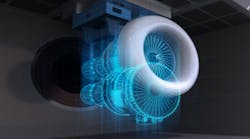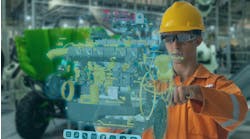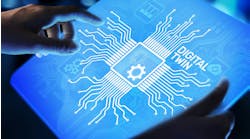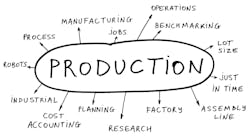Digital twins are trending. (Perhaps you already know this.)
A recent study predicts that up to 89% of all IoT platforms will include digital twins by 2025, which will alter how facility and IT managers collaborate as they transform industrial facilities and the processes within them. (Perhaps you’re already experiencing these changes.)
This trend, while hardly surprising, includes many facets and applications. Consider the use of digital twins in the energy space, which is the focus of Luis D’Acosta, executive vice president of Schneider Electric’s Digital Energy Division, who shares his perspective on digital energy and new capabilities with twinning it here...
Smart Industry: What differentiates digital energy from traditional energy? How does this affect energy consumers?
Luis: The main differentiator between digital energy from traditional energy is how we automate, monitor, control, and optimize using digital technologies. Digital innovation makes energy smart. Thanks to this the invisible becomes visible, eliminating waste and driving efficiency. Electricity is the most efficient energy, proven to be 3-5x more efficient and it is also the best vector for decarbonization. Digital solutions such as “optimizing procurement,” which tracks and analyzes energy performance to obtain the most accurate energy and carbon portfolio, enable us to gain key insights into the building’s landscape and identify different patterns of how consumers are using facilities and energy.
Additionally, the ability to unlock data potential in buildings helps prioritize the highest energy consumption, enabling facility managers to have complete control over a building’s carbon profile via visibility over operations of energy distribution. Adding to this, open-secure and centralized platform for real-time control and management can be used to assess the health and efficiency of HVAC systems, and power diagnostics can be automated once patterns are established to enable data transmission to optimize efficiency and make sustainability visible to managers.
Taking it a step further, the magic really happens when we can measure what’s happening in the physical world and correlate those sensors with behaviors. This allows users to witness first-hand how their actions have a direct impact on the building operations and its carbon footprint. The key solution for a more sustainable and resilient world requires all digital and all electric net-zero buildings. This approach, which entails buildings becoming self-generating assets, is a formidable path to net-zero operations and has the potential to improve energy efficiency by 40%.
Smart Industry: What role do digital twins play here?
The digital twin is an “evolving” digital profile of the end product or the overall composite system that brings together traditional simulation models with intelligent data and analytics. Digital twins are allowing us to build deeper into the realm of the possible. What if you could validate design before you build, reduce the risk of equipment failure, improve factory operations and energy efficiency?
A digital twin is the enabler. When based on reliable, high-quality data, digital twins enable a range of real-time insights that makes design, commissioning, and implementation easier, while improving productivity and operations across the digital value chain, including the digital customer service experience.
One main role of digital twins is to design sustainability and efficiency upfront. Digital-twin technology enables facility managers to generate virtual representations that can evaluate the anticipated carbon footprint of the building during the design phase. This approach not only creates a baseline that tracks and updates the building's design to achieve energy and operational efficiencies, but allows the opportunity to design for flexibility and ensure continuous improvement as technology evolves or as the building becomes utilized in new ways. Having the opportunity to adjust your building design ahead of time allows facility managers to really understand all the possibilities and construct against an already pre-optimized building strategy.
With a digital twin framework, you can also:
- Boost efficiency and safety through increased productivity and improved product design / quality, while distinguishing potential operator mistakes.
- Revolutionize the customer experience through streamlined product innovation, remote troubleshooting with context, and new digital business models (e.g., services).
- Streamline processes and data reliability through a digital thread that enables data continuity and provenance to track and explain data and a real-time continuum across otherwise disconnected CapEx and OpEx phases.
- Enhance enterprise digital culture through collaborations across many stakeholders from historical silos and a new way to upskill workforce for digital and attract digital natives.
With a successful digital twin-based platform, companies can reduce annual energy costs by 20%, with digital retrofits seeing an average playback in just 1-3 years. Incorporating digital twins as part of your environment can be used before and during any building-construction process for organizations looking to bring their data to life for better performance. It’s best to keep in mind that there is no one-size-fits-all approach. Start small and prioritize your business objectives to be achieved, while also being mindful that in the practical environment, there will be the need to integrate and possibly digital twins from multiple domains and vendors.
Schneider Electric and our partner ETAP have a long history of experience deploying electrical distribution systems and developing software and services that enable new methods for managing electrical systems. Recently we announced new digital-twin integration enabling operator training and simulations greatly reducing risk to operations. This integration allows all Schneider Electric’s EcoStruxure Power Operation systems to connect with ETAP Electrical Digital Twin on a continuous real-time basis what enables the operators to create and understand power system behavior during various real-world or plausible operating scenarios. This solution helps companies avoid unplanned outages caused by human error, reduce start-up and commission times, and evaluate operator awareness and readiness.
Smart Industry: What are the unique challenges in the energy space in this digital era?
Luis: The challenges we’re seeing within the digital energy space are not necessarily around new buildings themselves, but around “responsibility beyond compliance.” It's not enough to just comply with the building code; we need to do better. The building codes are typically lagging in what we need as a society to achieve sustainability and fight climate change. We can’t wait to take these sustainable steps; we must go beyond compliance to ensure productivity, efficiency and improve energy efficiency.
To do this, we must educate facility managers on the digital technologies that are widely available to modernize building management systems to improve sustainability and efficiency. Investing in digital-building solutions upfront will provide great payback not only financially, but for the planet. For example, building upon and enabling improvements of an old infrastructure building through digital simulations vs. demolishing buildings and starting from stretch. Construction costs a lot of money, and the cost would be monumental if we tore down old buildings to make way for new ones. We expect 50% of today’s buildings still be in use in 2050 and for that reason achieving a net-zero emissions scenario by the middle of this century requires 85% of the existing building stock to be retrofitted over the next three decades, along with all new buildings to be net zero-carbon from 2030 onwards.
This is where the power of digital technology is the enabler to simulate attributes of a retrofitted building. On top of a retrofit building approach providing a cost savings of 43-65%, digital models can be used to predict occupancy usages, energy demands and key building operations to show how the ROI on sustainable investment can take place.
Lastly, how do we modernize existing building infrastructure? We’re seeing a lack of education with existing buildings in need of retrofitting and modernized building-management systems that have different constraints due to older building-management systems. Instead of designing and building from scratch, we must salvage our existing building installations by implementing the tools, hardware, software and services to complement what already exists.
Today, we have technologies such as wireless, IoT, and connectivity directly to the cloud that allow us to modernize existing building infrastructures encompassing digitally driven energy-management initiatives.
Smart Industry: What most excites you about the near future of digital energy?
Luis: The continuous synchronization between the physical product and its digital representation provided by digital twins is very exciting and will unlock major opportunities for the future of digital energy. Built on reliable, continuous, and intelligent IT and OT data, the “digital thread” establishes the continuity across the product lifecycle and provides a “single source of truth”—the lifeline for accelerating outcome-driven ways to capture IoT’s business value.
Additionally, the integration of new building technologies that pair “all digital” with “all electric” is the recipe for a more sustainable and resilient world to accelerate the path to net zero and emission reduction. Being able to bridge the silos between mechanical and electrical processes to building-management systems, including EV charging infrastructures and microgrids and connectivity to the grid, is truly exciting because we now have the technology to really orchestrate all these assets to make the most of energy efficiency, resiliency and sustainability.



